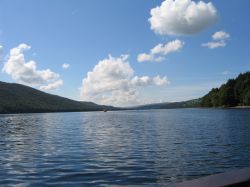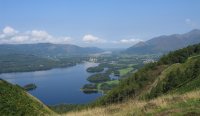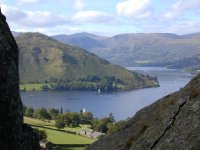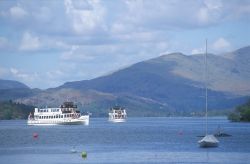A number of the larger lakes in Cumbria have ferry services operating on them.
Some are all year round services whilst others are seasonal.
There are a number of joint tickets which also allow travel by bus.
Coniston

Coniston Water is situated in the southern section of the county and is accessible from many of the main tourist centres by public transport. There are daily ferries operating on the lake throughout most of the year, with a reduced timetable during the winter. In addition, the National Trust have a restored steam gondola operating in summer.
Coniston Water is famous for its connection with Donald Campbell's World Water Speed Record attempts, but also has a range of other places of interest, including Brantwood (the home of John Ruskin) and Coniston Old Man (for fell walkers).
The village centre can be reached by bus from Ambleside, Ulverston and Windermere:
The ferry pier is a 10 to 15 minute walk from the bus stop near Tourist Information Centre.
Derwentwater

Derwentwater is one of two lakes adjacent to Keswick, the other being Bassenthwaite. Derwentwater forms part of the Borrowdale valley, close to many of the Lake District's highest mountains, including Scafell Pike and Great Gable. There are superb views around the lake and famous landmarks, such as Ashness Bridge and the Bowder Stone, are close by. It is possible to walk all around the lake or use one of the jetties to catch a return boat if a shorter walk is preferred. There are plenty of visitor facilities in Keswick itself and refreshments are also available in the small hamlet of Grange, close to the south end of Derwentwater.
The Keswick Launch Company offers ferry services and cruises throughout the year. Launches start their journey at Keswick boat landings and circulate round the lake in either direction, calling at the seven jetties situated at various points round the shore. A full trip round the lake takes approximately 50 minutes
Keswick can be reached by public transport from:
Ullswater

At approximately eight miles long, Ullswater is the second largest lake in the county. It is surrounded by a varied and attractive landscape, and has villages at either end providing visitor facilities and accommodation - Pooley Bridge to the north and Patterdale/Glenridding to the south. There are excellent walking opportunities in the vicinity, including a very popular lakeside route from Howtown back to Patterdale. Pooley Bridge, Glenridding and Patterdale can all be reached by public transport as can the well known Aira Force waterfall, which is situated on the western side of the lake. Helvellyn, the third highest mountain in England, can be climbed from the southern end of the lake via the well known 'Striding Edge' and 'Swirral Edge' ridges.
The ferry service is now all year round, although there is a reduced timetable in Winter.
Public Transport Links
Service 508 from Penrith and Pooley Bridge
Service 508 from Windermere via Kirkstone Pass (Easter until late October)
Service 73 from Keswick (Summer Saturdays only)
Windermere

Windermere is the largest lake in England and stretches for around nine miles between Ambleside at the north end and Newby Bridge in the south. Size and easy access also make Windermere the busiest lake and there are extensive tourist facilities and attractions within close proximity to its perimeter. There are frequent lake ferry and cruise services in summer with a reduced timetable operating in winter. Accessible by boat and road is the Lake District National Park Visitor Centre at Brockhole. A cross-lake car and foot passenger ferry service gives access to Hill Top (home of Beatrix Potter) and the picturesque village of Hawkshead, either by road, on foot or by bus in summer - Summer bus timetable.
The lake can be reached by national network rail via Windermere Station (connects to Oxenholme on the West Coast Main Line) and various scheduled bus services:
- 599 from Windermere Station; Ambleside and Grasmere
- 755 from Morecambe via Carnforth and Kendal
- 508 from Penrith, Pooley Bridge; Glenridding; Kirkstone Pass (Easter until Late October only)
- 555 from Kendal; Grasmere and Ambleside (evenings only)
At the south end of the lake there is a connection with the Lakeside and Haverthwaite Railway, a standard gauge line that often runs steam-hauled services.